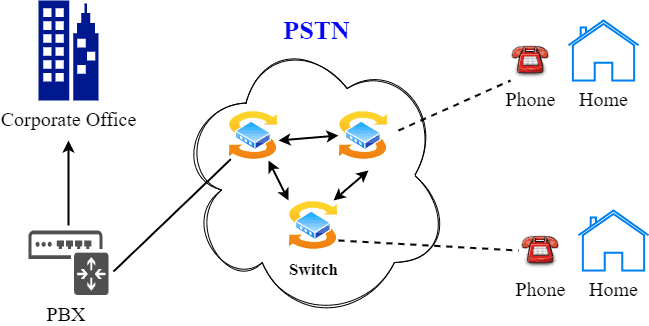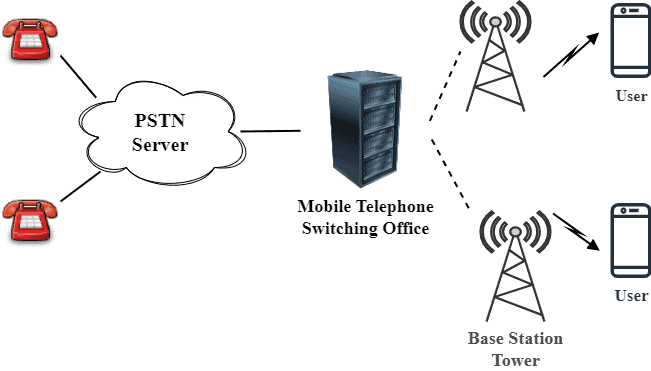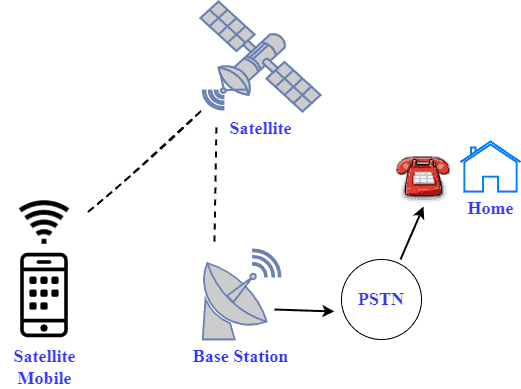1. Introduction
In this tutorial, we’ll talk about the Public Switched Telephone Network (PSTN) along with its working principle.
2. What Is PSTN?
The Public Switched Telephone Network (PSTN) constitutes the interconnected voice-centric public telephone networks worldwide. It is characterized as the conventional circuit-switched telephone network, encompassing all switched telephone networks operated by local, national, or international carriers. The PSTN serves as the comprehensive infrastructure, delivering the essential services for public telecommunication.
It operates on circuit-switched technology, establishing a dedicated communication path throughout the call. In contrast, contemporary internet-based communication relies on packet-switched technology, which differs from the dedicated path approach of the PSTN.
3. Core Principles and Architecture
The Public Switched Telephone Network (PSTN) operates based on several core principles that define its functionality and structure. Below are the key principles of the PSTN.
Each phone is typically assigned a unique and dedicated address, commonly called a telephone number. This address facilitates establishing a connection when making a call, as the network uses this information to route the call to the correct destination.
The PSTN uses a circuit-switched architecture. For the duration of the call, the caller and recipient establish a dedicated physical connection. This circuit remains open for the call, ensuring a continuous and reliable connection. The below image is the basic architecture of PSTN:

When dialing a number, the phone sends a signal through the network indicating the recipient’s phone number. Interconnected switches, like traffic lights on a complex road network, route this signal until it reaches the correct destination.
The system converts the voice signal into electrical signals and divides it into smaller units called channels. The system then multiplexes these channels, combining and transmitting them together over the same physical circuits to efficiently utilize network resources.
These are the core principles that make the PSTN work. While evolving technologies like Voice over IP (VoIP) are challenging its dominance, the PSTN remains crucial for emergency services, reliable communication in remote areas, and interoperability between different networks.
4. Types of PSTNs
There are several types of Public Switched Telephone Networks (PSTNs) catering to different needs and environments.
4.1. Fixed-Line PSTN
It’s the traditional way of making and receiving phone calls through a network of physically connected wires. The phone sends an electrical signal through the network of switches and cables. These switches route the signal to the recipient’s phone. Once the connection is established, a clear and reliable voice call can be enjoyed:


Fixed-line PSTNs are notoriously reliable, and less prone to interference and network congestion compared to wireless options. Calls generally offer superior sound quality compared to mobile networks or internet-based voice communication (VoIP).
The disadvantage is usage has been declining with the rise of mobile networks and VoIP, leading to some service providers scaling back their offerings. The limitation is tied to the location of the phone and its physical connection. Installing and maintaining landline services can involve fees and ongoing costs.
4.2. Mobile PSTN
The Mobile PSTN, a cellular network, is a modern marvel allowing users to make and receive phone calls from anywhere within its coverage area. It’s a dynamic system that seamlessly connects mobile phones to other phones across the globe, revolutionizing communication with its mobility and flexibility.
The mobile phone connects to nearby cellular towers with antennas and transmitters. Dialing prompts a radio signal to the nearest tower, which relays it through interconnected switching centers, identifying the recipient’s location. The signal then reaches the recipient’s phone via the appropriate tower, establishing a two-way voice connection:

The major advantage is users can make and receive calls from anywhere within the network coverage, and the disadvantage is the call quality and connection availability depend on the strength and congestion of the cellular network within the location.
4.3. Satellite PSTN
It’s a unique alternative to traditional phone networks, providing voice communication by bouncing signals off orbiting satellites, not through wires or cell towers, but via spacecraft millions of kilometers away.
The satellite terminal sends the sender’s voice signal to a nearby satellite transponder, which amplifies and relays it back to Earth, targeting another satellite or a ground station. The PSTN network then routes the signal, reaching the recipient’s phone or terminal via another satellite or terrestrial infrastructure:

Satellite PSTN offers global coverage, making it suitable for remote areas where landline infrastructure is challenging or economically unfeasible.
The disadvantage is the infrastructure costs associated with launching and maintaining satellites, as well as the cost of user terminals, ground stations, and transponders, can be significantly higher compared to terrestrial networks.
5. Voice Over IP (VoIP)
On the other end, Voice over IP (VoIP) redefines phone calls by transmitting voice using the Internet instead of landline. People see VoIP as an alternative to PSTN.
The device converts voice into digital data packets. These packets travel through the internet infrastructure, similar to browsing websites. VoIP servers route the packets based on the dialed number, utilizing existing PSTN networks or dedicated VoIP infrastructure. Finally, the recipient’s device reconverts the data packets back into voice:

VoIP calls are often significantly cheaper than traditional phone calls, especially for international calls and long-distance communication. Call quality relies heavily on internet speed and stability. Poor internet connections can lead to delays, dropped calls, and choppy audio.
6. Applications
The primary function of PSTN is to enable individuals to connect with others through voice calls. Sending and receiving documents and images over PSTN lines through fax machines.
PSTN networks often stay operational during power outages and natural disasters, providing vital communication lifelines.
Satellite PSTN provides essential voice communication services in extremely remote regions or offshore locations.
PSTN-based systems still handle some financial transactions in banking, including automated phone banking and payment services.
7. Challenges and Future
Internet-based Voice over IP (VoIP) offers cheaper calls, flexibility, and advanced features, attracting businesses and individual users away from PSTN. The circuit-switching technology of PSTN limits its adaptability to modern needs like data services and multimedia communication. With fewer users and competition, PSTN revenue streams are shrinking, making it harder to invest in upgrades and modernization.
PSTN can integrate with VoIP and other technologies, offering hybrid systems that leverage the strengths of each for specific needs. It may remain crucial for emergency services, rural areas with limited internet access, and network interoperability. PSTN operators may gradually transition towards IP-based technologies while maintaining compatibility with existing infrastructure.
8. Conclusion
In this article, we discussed PSTN, which constitutes the interconnected voice-centric public telephone networks worldwide. It operates on circuit-switched technology, establishing a dedicated communication path throughout the call. While evolving technologies like Voice over IP (VoIP) are challenging its dominance.